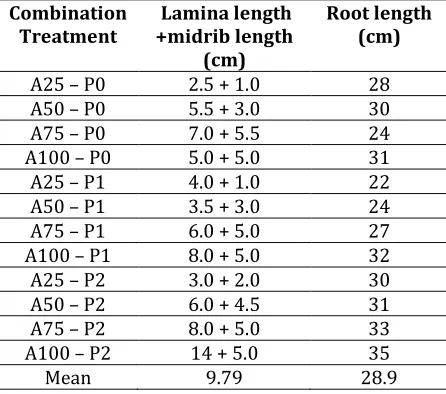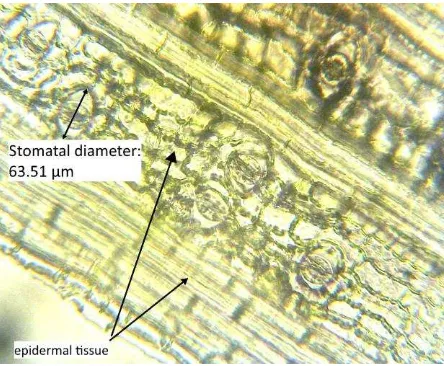Available online at http://journal.walisongo.ac.id/index.php/jnsmr
Anatomical Responses of Ajwa Dates Sprouts
(
Phoenix dactylifera
L.) tonWater Availability and light Intensity
Dian Triastari Armanda
Department of Biology Education, Walisongo State Islamic University, Central Java, Indonesia
Corresponding author: dian.armanda@walisongo. ac.id
Telp. (+62-24-7601295) Recived: 15 May 2015, Revised : 30 May 2015 Accepted: 28 June 2015
Abstracts
As the biggest Moslem population in the world, Indonesia still has a high dependency on importing date palms from other countries. Ajwa dates (Phoenix dactylifera L.) is one of special date palm cultivar which had cultivated since 5000 BC in arid climate area in Saudi Arabia. Adaptation and optimation of environmental factors for Ajwa dates cultivation in Indonesia are important to be conducted to meet the date palm demand of this country. A study on anatomical responses of Ajwa dates sprouts to water availability and light intensity has been conducted. Ajwa date sprouts had been exposed to combinations of three shade variations (0%, 50%, and 90% shade) and four water availability variations (25%, 50%, 75%, and 100% of the field capacity). Data were taken from day 0 until day 45 of germination. Morphological parameters which observed and analyzed were the leaf blade length and sprouts root length. Anatomical parameters which observed and analyzed were root radius, stele diameter, leaves numbers, leaves thickness, and stomatal diameter. Variations on water availability and light intensity gave the same effect (not significantly different) in almost every parameters which measured, therefore, the most optimal combination water-light treatment was still unknown. Advanced research and longer duration of experiment need to be conducted to gain the complete information regarding the optimization of environmental factors to increase the Ajwa date productivity in Indonesia.
Key words: Ajwa date palm (Phoenix dactylifera L.), shade, water, anatomical reponses
1.
Introduction
Ajwa date palm (Phoenix dactylifera L.) is a monocot arid climate plant which twenty times stated in the Holy Quran. Arabic
which can be used as medicine for heart disease, cancer, neurological diseases, gastrointestinal diseases, and diabetes. Date palm sap is an important source of healthy drinks ingredient. Its fiber can be woven into clothing, beside the other parts of the tree can also be used in the construction of houses [1, 2, 3, 4, 5].
Arecaceae family is also known as Palm family has 4000 species distributed over 200 genera. Genus Phoenix has 12 species and among them, 5 are edible including Phoenix dactylifera. There are almost 3000 cultivators of Palm family all over the world [6].
As the biggest Moslem population in the world, Indonesia still has a high dependency on importing date palms from other countries (Tunisia, Egypt, Iran, United Emirates Arab, Malaysia, Israel, Saudi Arabia, China, Algeria, and Australia). In half year of 2012, Indonesia had been imported as much as 16.2 thousand tons of dates (which were worth 20 million USD)[7].
Date palm can also be cultivated in tropical countries because it has a high adaptability. Desert climate is characterized by very low rainfall (<250mm/year), low humidity, and high-temperature amplitude between night and day [8]. If cultivated in Indonesia water and light are important factors that influence the growth success and development of the date palm [9, 10].
The objectives of this study were to examine optimal combination of water availability and optimal light intensity for the growth and development of the date palm sprouts through morphological and anatomical observations. The object material of this study is limited to date palm sprouts/seedling (life phase between germination and sapling phase). The date palm cultivar which chosen is Ajwa Date because it classified as Indonesian favorite cultivar and relatively high price compared to other varieties.
2.
Experiments Procedure
Ajwa date palm seeds (P. dactylifera) which had been cleaned and soaked in water
for 24 hours were germinated in sealed plastic containers which equipped with moist cotton. Containers then stored in a dark place. The germinated seed which already has radicle and plumule then transferred into growth medium polybags which consist of combinations between organic humus, organic manure, rice husk, and sands (2:1:1:1). This seedling were exposed to combinations of three shade variations (0%(P0), 50%(P1), and 90%(P2) shade) and four water availability differences (25%(A25), 50%(A50), 75%(A75), and 100%(A100) of the field capacity) in three times repetitions.
Morphological parameters which observed and analyzed were the leaf blade length and root length. Anatomical parameters which observed and analyzed were root radius, root stele diameter, leaves number, leaves thickness, and stomatal diameter. Optilab was used for these anatomical measurements.
3.
Result and Discussion
56,7% Seed viability gained under germination program held on early October 2014 (temperature average was 30°C). On day 45 of germination (it had reached sprout/seedling phase) some morphological and anatomical parameters were observed. The measured leaf length and root length of Ajwa Dates seedling are shown in Table 1. Data variation figured leaf length ranged from 3.1 cm to 19 cm, and root length ranged from 22-35 cm.
Statistical analysis showed the more water availability contributed to longer leaf
Sig. . , α= . but it do not significantly
Ajwa Date which has been adapted to arid climates generally showed massive roots to gain more water. Dates which grown in dry climates will try to reach the source of water as deep as possible from the soil to keep the nutrient flow continuously [11]. High temperatures during the day in arid climates causing transpiration rate becomes very high. It was predicted that dates adapted in wet tropical climate area (Indonesia) would have less massive roots because of higher water availability of the soil and higher air humidity in the tropical area [10]. This research data had revealed some proofs of the theory.
Table 1: The mean of leaf length and root length of Ajwa Dates sprout in 12 combination treatment on water availability and light intensity
Combination treatments were not significantly different (Sig. 0.075 and 0.12, respectively).
Development of the root structure is important in the survival and growth of the date palm. As a young plant, these Ajwa date root seedlings showed massive cortex tissue compared to other palm species. Water is stored mainly in the cortex tissue (Fatima et al.,2012). Formation of Aerenchyma in the roots, due to the gas transfer of the cortex, can
enhance diffusion of the photosynthetic and atmospheric oxygen from shoot to roots [11].
Figure 1. Cross sections of root from P. dactylifera seedling. Root branch protrusion was emerged from root stele in day 45 of germination (specially occured from A25 – P0 and A25 – P1 treatment).
The exodermal and hypodermal compact cell layers in the date palm roots can play a role in the preventing collapse of the cortex. It may also be an important structural framework for the aerenchyma formation. Abnormalities in the structure of the root vascular tissues can be attributed to the extreme environment in cultivation, such as water potential, air humidity, and CO2. The emerging root branch protrusion in figure 3 was showed only from treatment A25–P0 and A25-P1. The lowest water availability (25% of the field capacity) combined with highest natural light intensity (0% shade and 50% shade) stimulated the occurrence of the root branch.
Anatomical observation also found that the young leaves that emerged were a compound leaves which consist of five to seven leaflets in average (Figure 2). The compound leaves were still folded circularly and merely like a single tubular leaf when it was seen macroscopically.
tissue and were mostly founded in lamina fold. Average leaf thickness was 325±72 µm and it was not significantly different (Sig. 0.35) from the twelve set experimental series.
Figure 2. Cross-sectional visualization of P. dactylifera seedling complex leaves. The figure clearly shows epidermal tissue, collenchymal tissue, and vascular tissue of the leaflets.
Deeper observation on epidermal tissue revealed stomatal features. Stomata are vital structures responsible for the gas exchange of plant primordia /seedling in the processes of photosynthesis and respiration.
Figure 3. Paradermal sections of adaxial surface of leaves from P. dactylifera seedling. The figure clearly shows stomatal features.
Stomata on P. dactylifera were surrounded by 4-6 neighbour cells/subsidiary cells which 2 of them were round and smaller
than the other and were located at the tip of the guard cells (Figure 3). Stomata in the same level than epidermal cells. The mean stomatal
diameter were . ± μm and it was not
significantly different from the twelve set experimental series (Sig. 0.095). Epidermal cells located near with stomata are thinner and smaller than those which found farther. Although the twelve treatment set had been done and the comparison analysis significance number were different (some of them were
near to . α , statistically, the effects were
relatively same.
4.
Conclusion
Combination of variation in water availability (25%, 50%, 75%, dan 100% of the field capacity) and light intensity (0%, 50%, and 90% shade) gave the relatively same effect (not significantly different) almost in every morphological and anatomical parameters measured from 45 day germination on Phoenix dactylifera L. (Ajwa date palm). Therefore, the most optimal variation treatment to cultivate Ajwa date was still unknown. Advanced research (specifically on climate adaptation) and longer duration of experiment need to be conducted to gain a complete information regarding the optimization of environmental factors for the cultivation of Ajwa date in this tropical country.
Acknowledgment
The study was financed by Walisongo State Islamic University (Semarang) through the annual research grant. The author is grateful to the life sciences reviewer team of this research program. Special thanks also go to Sumiati for her technical assistance in the field.
References
Teknik Budidaya. Pustaka Baru Press. Yogyakarta (2009).
[2] T.H. Malihi, M.I. Qadir, M. Ali, B. Ahmad, Y. H. Khan, and A.U. Rehman, Ajwa Date (Phoenix dactylifera): An Emerging Plant in Pharmacological Research. Pak. J. Pharm. Sci. 27 (3) (2014) 607-616.
[3] A.R. Ragab, M.A. Elkablawy, B.Y. Sheik, and H.N. Baraka. Antioxidant and Tissue Protective Studies on Ajwa Extracts: Dates form Madinah Al Monwarah, Suadi Arabia. J. Environ. Anal. Toxicol. 3 (1) (2013) 1-8. [4] P. A. Retnowati, and J. Kusnadi, Pembuatan
Minuman Probiotik Sari Kurma dengan Isolat Lactobacillus casei dan Lactobacillus plantarum. Jurnal Pangan dan Agroindustri, 2 (2) (2014) 70-81. [5] Rostita, Khasiat dan Keajaiban Kurma.
Penerbit Qanita, PT. Mizan Pustaka. Bandung (2009).
[6] T. H. Mallhi, M.I. Qadir, M. Ali, B. Ahmad, Y. H. Khan and A. U. Rehman, Ajwa Date (Phoenix dactylifera ): An Emerging Plant in Pharmacological Research, Pak. J. Pharm. Sci., .27 (3) (2014) 607-616.
[7] ----. Fisheries and Aquaculture
Department, The Republic of Indoneisa BPS (2012).
[8] Hartono. Geografi: Jelajah Bumi dan Alam
Semesta. Penerbit Cipta Praya. Bandung
(2007).
[9] M.A.A. El-Baky, Using Morphological and Anatomical Features as Taxonomical Evidence to Differentiate Between Some Soft and Semi-Dry Egyptian Cultivars of Date Palm. Journal of Horticultural Science and Ornamental Plants, 4 (2) (2012)195-200.
[10] P.J. Kramer and T.T. Kozlowski , Physiology of Woody Plant. Academic Press, New York (1979).

